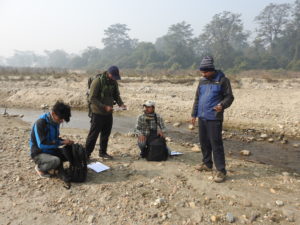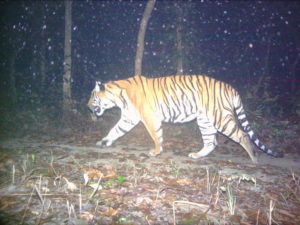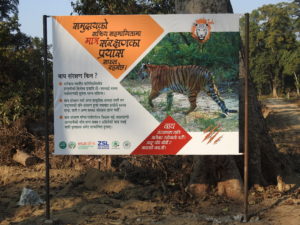ZSL Nepal has been conserving wild tiger in Nepal for over 25 years and in the Parsa National Park (PNP) and its buffer zone since 2014. WildCats Conservation Alliance has been focusing its support on this work in PNP and especially in a recently annexed 129 sq. km area (called PNP extension area; PNPea) provides a platform for the tigers to recolonize the eastern landscape, where they disappeared from after the 1970s.
With the recent increase in the tiger population in PNP, there has been growing evidence of tigers moving beyond the boundaries of PNP and into surrounding community forests. While this is encouraging, it also presents a challenge in the form of growing human-tiger conflict.
This latest project report from ZSL Nepal describes the activities carried out in 2020 aimed at understanding tigers and other wildlife species in this unprotected landscape. At the same time, by exploring avenues for community engagement through surveys, meetings, and awareness programmes, the project builds inclusivity and support for tiger conservation. The project works in collaboration with the Department of National Parks and Wildlife Conservation (DNPWC), local Forest Users Groups (FUGs) and the Divisional Forest Office (DFO).
Project activities and key achievements:
- 500km2 rapid wildlife and habitat assessment of mammals, birds, and vegetation designed planned and carried out over 44 days by 11 team members. It recorded 22 different mammals species (including Bengal tigers).
- Community engagement was carried out in three community meetings conducted for 102 community members in three CFUGs to identify human wildlife conflict (HWC) vulnerability and perception towards tigers and level of forest reliance. Results suggest tigers were tolerated as they ate herbivore pests and encouraged tourism.
- 276 households were surveyed. 30 % were identified as vulnerable based on their income, standard of living and proximity to the forest.
- The human wildlife conflict data was mapped across the assessment area to inform local authorities on localities at risk to work to mitigate its impact and help guide tiger conservation outside protected areas.
- Three school awareness programmes were conducted, reaching 179 students directly. Leaflets were distributed using student networks to reach more than 2,500 students and three eco-clubs were reformed as tiger champion conservation clubs. Participants have an improved view of tiger conservation, with students reporting an increased willingness to support tiger conservation. All students agreed that tiger conservation is a priority, and they have a responsibility to spread awareness in their community.
- Three information boards were installed near the entrances to the respective community forests, estimated to reach more than 1,500 people daily.
- 2,500 brochures were distributed in the communities highlighting information on tigers, their habitat conservation along with conflict mitigation measures.
- A one day training workshop was conducted for 35 participants including representatives from local government, CFUGs, DFO and selected community members with the aim to share information on tiger behaviour, tiger conservation and its long-term benefits, adopting measures for HWC mitigation including conflict with the tiger, and accessing relief mechanisms.




